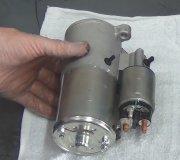BASIC IGNITION SYSTEM CHECKS
DIS (EXCEPT 3.4L)
Spark
If factory tachometer is connected to coil tachometer terminal, disconnect tachometer before performing tests. When removing spark plug wire from spark plug, twist and pull on boot. DO NOT pull on wire.
Using Spark Tester (J-26792), check for spark at each spark plug wire. Leave other wires connected while checking for spark. Check spark plug wire resistance on suspect wires. Resistance should be about 30,000 ohms.
Ignition Coil Power Source
CAUTION:DO NOT insert DVOM leads into ignition coil connectors. Connector terminals may be damaged. When using DVOM, ensure lead contacts front edge of terminals only.
Turn ignition on. Check ignition positive voltage circuit of ignition control module for battery voltage. See appropriate wiring diagram in WIRING DIAGRAMS article. If battery voltage is not present, check fuse for ignition control module circuit. If fuse is not open, check for open in circuit between fuse and ignition control module.
Ignition Coil Test (2.2L, 4.3L, 5.0L, 5.7L, 6.5L & 7.4L)
Turn ignition off. Remove engine cover. Disconnect wiring from ignition coil and distributor lead.
Using DVOM, check for continuity between coil primary terminal and exterior case of coil (ground). Replace ignition coil if continuity is present.
Using DVOM, measure resistance between coil primary terminals. Replace ignition coil if resistance is not 0.1 ohm.
Using DVOM, measure coil secondary resistance. Replace ignition coil if resistance is not 5000-25,000 ohms.
Reconnect distributor lead and wiring to ignition coil. Install engine cover.
Ignition Coil Test (4.8L, 5.3L & 6.0L)
Turn ignition off. Disconnect wiring from ignition coils.
Using DVOM, measure resistance between ignition coil terminal "A" and ignition coil mounting bracket. See appropriate wiring diagram in WIRING DIAGRAMS article. Replace ignition coil if resistance is not 0-10,000 ohms.
Using DVOM, measure coil secondary resistance. Replace ignition coil if resistance is not 3000-7000 ohms.
DIS (3.4L)
Electronic Ignition System Diagnosis (Primary Ignition Check)
Perform On-Board Diagnostic (OBD) system check. See ON-BOARD DIAGNOSTIC (OBD) SYSTEM CHECK in appropriate SELF-DIAGNOSTICS article. After performing OBD system check, go to next step.
If any Diagnostic Trouble Codes (DTCs) are present, diagnose DTCs. See appropriate SELF-DIAGNOSTICS article. If DTCs are not present, go to next step.
Start engine. If a no start condition or hard-start condition is present, go to next step. If engine starts okay, go to step 5.
Turn ignition off. Disconnect Ignition Control Module (ICM) harness connector C2. Turn ignition on. Using DVOM measure voltage between ground and ignition battery voltage circuit at ICM harness connector C2. See appropriate wiring diagram in WIRING DIAGRAMS article. If voltage is less than 10 volts, go to next step. If voltage is 10 volts or greater, go to NO START-ENGINE CRANKS OKAY (3.4L) under NO START DIAGNOSIS.
Drive vehicle and note driveability problems such as miss, stumble or hesitation. If driveability problem is present, go to ELECTRONIC IGNITION SYSTEM DIAGNOSIS (SECONDARY IGNITION CHECK). If driveability problem is not present, go to next step.
If any other driveability problem is present, go to appropriate TROUBLE SHOOTING - NO CODES article. If no other driveability problems are present, go to step 8.
Check ELEK IGN fuse (10-amp), located in underhood junction block. If fuse is open, repair short to ground in ignition battery voltage circuit between fuse and ICM. Replace fuse. If fuse is okay, check for open in ignition battery voltage circuit. See appropriate wiring diagram in WIRING DIAGRAMS article. Check for loose or corroded terminals and connections. Repair as necessary. After repairs, go to next step. If circuit, terminals and connections are okay, go to appropriate TROUBLE SHOOTING - NO CODES article.
Operate vehicle within conditions in which problem occurred. If driveability problem is present, perform On-Board Diagnostic (OBD) system check. See ON-BOARD DIAGNOSTIC (OBD) SYSTEM CHECK in appropriate SELF-DIAGNOSTICS article. If driveability problem is not present, system is okay.
Electronic Ignition System Diagnosis (Secondary Ignition Check)
Perform NO START DIAGNOSIS diagnosis. See NO START-ENGINE CRANKS OKAY (3.4L) under NO START DIAGNOSIS. After performing no start diagnosis, go to next step.
Install scan tool. Turn ignition on. If any Diagnostic Trouble Codes (DTCs) are present, diagnose DTCs. See appropriate SELF-DIAGNOSTICS article. If DTCs are not present, go to next step.
Using scan tool, perform Fuel Injector Balance Test. See FUEL SYSTEM in appropriate SYSTEM & COMPONENT TESTING article. Note cylinders with no engine speed or idle quality change. If any cylinders were noted, go to next step. If no cylinders were noted, go to step 17.
If 2 companion c
Monday, May 1st, 2017 AT 9:17 PM
(Merged)



